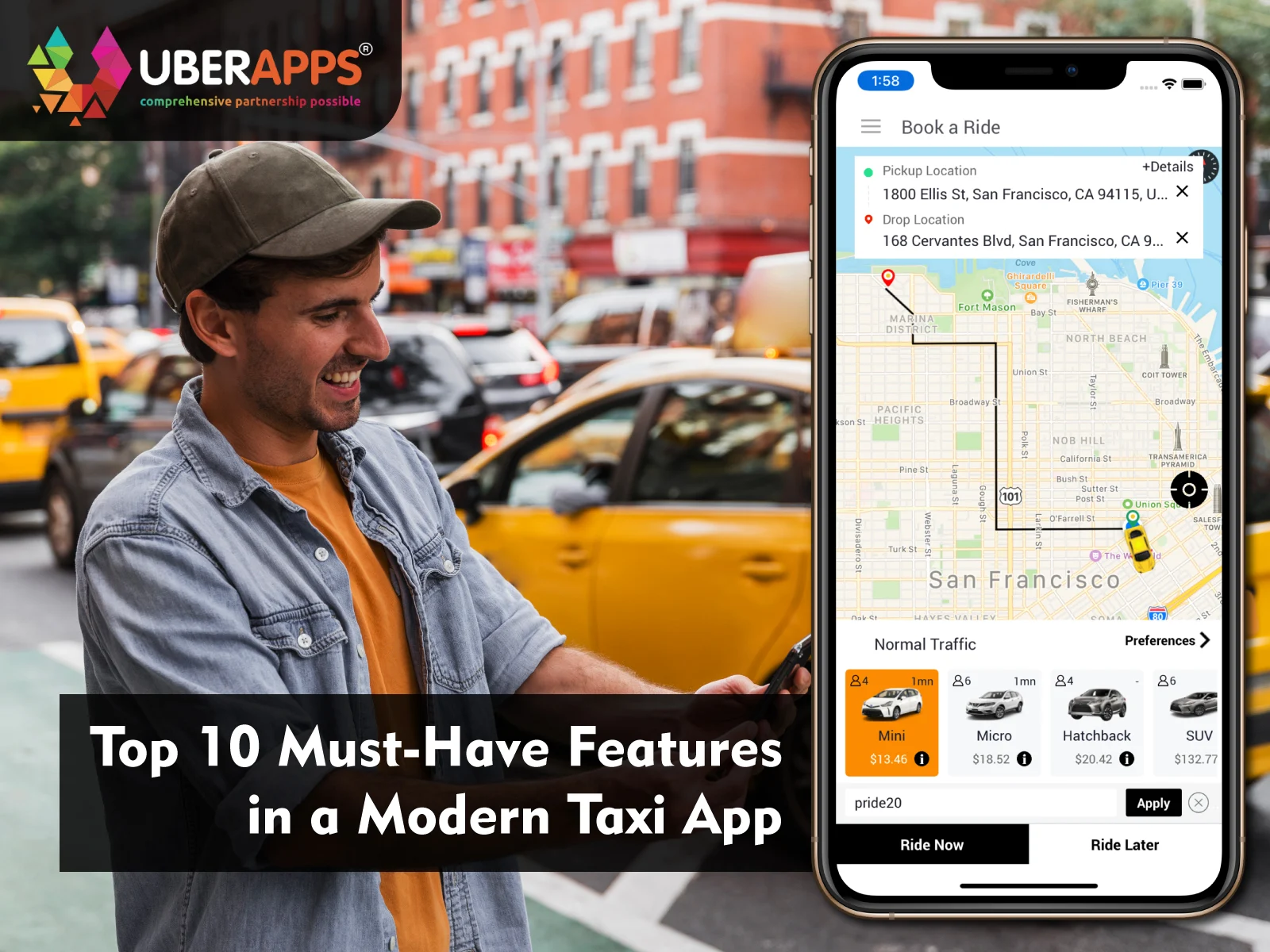
Top 10 Must-Have Features in a Modern Taxi App
The taxi industry has undergone a massive transformation with the rise of ride-hailing apps like Uber, Bolt, and Lyft. Today, launching a successful taxi business means offering a seamless digital experience powered by smart features, intuitive design, and real-time convenience.
Whether you’re developing a new Uber clone, enhancing an existing taxi booking app, or exploring innovative taxi app development ideas, having the right set of core features is essential.
In this blog, we’ll explore the top 10 must-have features every modern taxi app needs to attract users, boost engagement, and stay competitive in the fast-evolving mobility market.
In today’s fast-moving ride-hailing market, launching a competitive taxi app means more than simply enabling booking. Whether you’re building a full-blown Uber clone or a local taxi booking app, you need to include the right features that attract drivers and riders alike. This post covers the top 10 must-have features for modern taxi app development, including seamless registration, real-time GPS and tracking, flexible in-app payments, safety tools, driver dashboards, and admin-level control. We pay special attention to taxi booking apps’ key demands—scalability, convenience, safety, payment integration and user-friendly design. If you’re planning to invest in taxi app development, this roadmap gives you both the feature checklist and practical insights to stand out in the ride-hailing landscape.
Top 10 Must-Have Features in a Modern Taxi App
In this guide, we’ll walk you through the essential features for your taxi booking app (Uber clone style) and explain why each one matters in today’s ride-hailing market.
1 Smooth Onboarding & Profile Management
Rider Registration & Login
Enable one-tap signup via email, phone number or social login for passengers.
Let users add profile info, favourite locations, payment methods.
Takeaway: Easy onboarding reduces drop-off and drives retention.
Driver Onboarding & Verification
Drivers should upload documents, get verified, set availability.
A clean driver dashboard improves acceptance rates and service quality.
2 Instant Ride-Hailing & Flexible Booking Options
Ride Now (On-Demand)
Allow users to book a ride with minimal steps, instantly matched with a driver.
Ride Later (Scheduled)
Provide “book for later” to accommodate airport trips, planned travel.
Takeaway: Offering both on-demand and scheduled options widens your market.
3 Real-Time GPS, Live Tracking & Route Optimization
Rider Side Tracking
Passengers should see driver location, ETA, vehicle details.
Driver Navigation & Heat Map
Embedded maps, live traffic data, hotspot zones for better driver efficiency.
Takeaway: Real-time geolocation builds trust and reduces wait-time anxiety.
4 Flexible In-App Payments & Transparent Fare Structure
Multiple Payment Methods
Accept cards, wallets, UPI/cash (depending on market).
Fare Estimates & Breakup
Show ride cost estimate + detailed fare breakdown (distance, waiting time, surge).
Takeaway: Transparent payment builds user confidence; flexible payments remove friction.
05 Safety & Trust Features
SOS/Emergency Button & Trip Sharing
Include panic button, share-trip link to contacts.
Ratings, Reviews & Driver Info
After ride, both sides rate each other; show driver picture, vehicle details.
Takeaway: Safety and trust are non-negotiable in a taxi booking app.
6 Driver & Fleet Management Features
Driver Dashboard & Earnings Summary
Drivers view completed rides, earnings, incentives, shift logs.
Availability Toggle, Accept/Reject Ride
Let drivers switch online/offline; manage ride requests.
Takeaway: A driver-friendly app retains your workforce and boosts service quality.
7 Admin Panel & Operational Control
Real-Time Analytics, Surge Pricing & Geo-Fencing
Admin panel to view live rides, driver status, apply dynamic pricing, zone rules.
Reporting, Fraud Detection & Multi-Role Access
Monitor cancellations, abuse, driver/vehicle compliance, region-based settings. Grepix Infotech
Takeaway: Robust backend controls separate ordinary taxi apps from successful fleet ops.
08 Ride-Sharing, Multi-Stop & Additional Service Options
Shared Rides & Pooling
Allow passengers to share rides, cut cost, optimise drivers.
Multi-Stop Trips, Outstation & Vehicle Classes
Book ride with multiple stops, choose sedan/SUV, include inter-city/outstation options.
Takeaway: These advanced ride-hailing app features increase usability and revenue streams.
09 Surge Pricing, Promotions & Loyalty
Dynamic Pricing Logic
Adjust fare based on time, zone, demand, event.
Promo Codes, Referral Bonuses, Wallet Credits
Incentivize new users, retain existing ones with loyalty programs.
Takeaway: Smart pricing and rewards drive growth and keep competition at bay.
10 Scalability & Market-Adapted Features
Multi-Language, Multi-Currency, Regional Compliance
For global expansion or diverse markets.
Future-Ready: AI, EV Integration, Analytics
AI routing, predictive demand, support for electric vehicles + advanced dashboards.
Takeaway: Building with scalability and adaptability future-proofs your taxi booking app investment.
Conclusion
When you embark on taxi app development, especially an Uber clone or ride-hailing platform, it’s critical to go beyond the basics. The ten features outlined here form the backbone of a competitive, modern solution: easy onboarding, instant + scheduled ride booking, live GPS and tracking, flexible payments, top-tier safety tools, driver/fleet management, admin controls, advanced ride-sharing mechanics, smart pricing & loyalty systems, and scalable architecture for future growth.
In a world where users expect seamless, safe, and efficient travel—and drivers expect clarity, fair earnings, and good technology—meeting these requirements is non-negotiable. Whether you’re targeting a local city launch or aiming for wider scale, make sure your taxi booking app checks off each of these boxes. By doing so, you position your platform for strong user adoption, operational efficiency, driver retention and revenue growth. Remember: users don’t just use taxi apps—they trust them, rely on them, and expect a high-quality experience every single time. Build with that mindset, and your taxi app will stand out from the crowd.
FAQS
1. What is the difference between a basic taxi app and a full Uber clone?
A full Uber clone includes rider-app, driver-app, admin panel, plus advanced features such as ride-scheduling, multi-stop bookings, surge pricing and analytics—whereas a basic taxi app may only offer simple immediate booking and payments. Markovate
2. How many payment methods should a taxi booking app support?
At minimum, support card payments and cash (where applicable). Ideally include mobile wallets, UPI, in-app wallet or split-pay features to cover different user segments. Code Brew Labs
3. Why is a driver dashboard important in taxi app development?
A driver dashboard gives transparency to drivers about rides, earnings, incentives and availability. That improves driver satisfaction, reduces churn and fosters better service. ubertaxiclone.com
4. What role does safety play in ride-hailing app success?
Safety features like SOS buttons, live tracking, driver info and reviews help build trust with riders and drivers alike, which is critical in competitive markets. ubertaxiclone.com
5. Can a taxi app scale beyond a single city? What features must it include?
Yes—scalability demands multi-language/multi-currency support, regional pricing/compliance, ability to add extra service types (pooling, outstation), and strong admin controls for multiple zones.
Author's Bio

Vinay Jain is the Founder of UBERApps and brings over 10 years of entrepreneurial experience. His focus revolves around software & business development and customer satisfaction.

